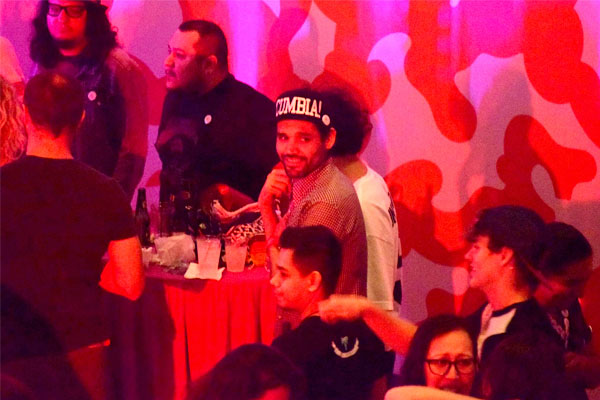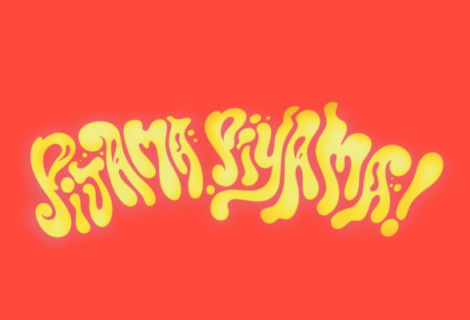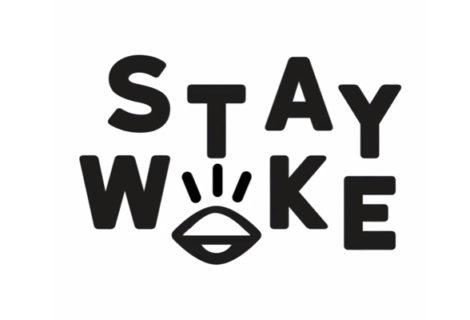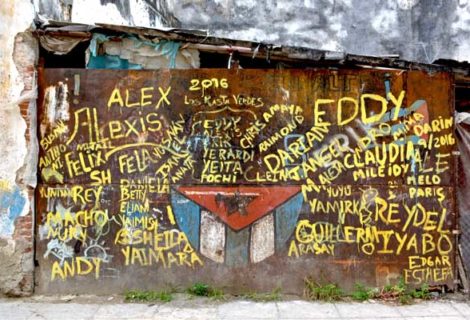DJ Nico: The Cumbia Godfather of La Phoenikera
Nico Paredes doesn’t care if people know who he is or what he does for a living; he doesn’t want fame, to be recognized on the street or to be praised. He doesn’t give a shit about the perks of being a DJ/promoter in La Phoenikera or that people appropriate his ideas and materialize them without involving him. He doesn’t want your compliments, your applause or your approval. As a matter of fact, he’s not even interested in money, Nico only wants Cumbia.
The first time I went to a party organized by this illustrious Phoenikero it was at a warehouse on Grand Ave. a few lustrums ago. The place was dark, it smelled like paint, your drunk uncle, and some cannabinoid fumes. A few gringuitos –who probably snuck into the party–, were enthusiastically dancing to some electropop tune that only they were paying attention to. The rest were getting shitfaced and doing their own thing. There was no turntable at the DJ booth, just a computer monitor and a tower from which Nico played his favorite jams.
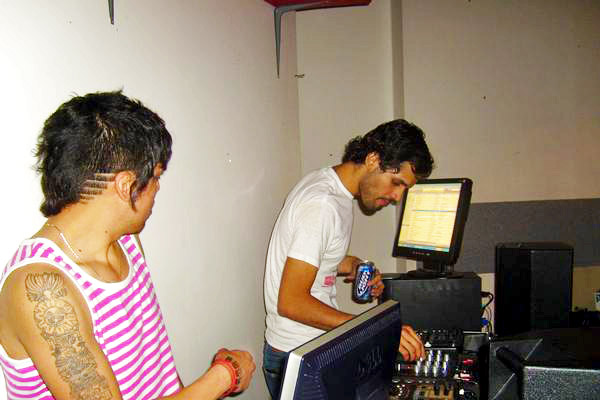
Jorge Ignacio and DJ Nico jamming it up at Propaganda c. 2006. Photo: Nico Paredes.
It is likely that all the partygoers –including me–, zigzagged our way to this place after being yelled to “get the fuck out” of the Bikini Lounge. It was a place where Phoenikerxs with similar interest could party hardy and listen to music that wasn’t played anywhere else.
At a certain point of the night –or early morning–, when everything was kind of chill, Nico woke the fuck outta everybody by playing some ratchety Cumbias and needless to say, people were possessed by the Cumbia demons and started dancing uncontrollably as it usually happens when Nico plays a set. The gringuitos didn’t know what the hell was going on, it was like that scene in Beetlejuice (Day-o, day-ay-ay-o). It was a cool night like others at that joint…too bad it lasted only a few months.
This was like a decade ago when Nico and two friends (Jorge Ignacio Torres and Isela “Chela” Meraz) opened Propaganda, an art gallery dedicated to promoting local Latinx artists that weren’t showcased at traditional galleries in downtown La Phoenikera, and also to throw legendary parties.
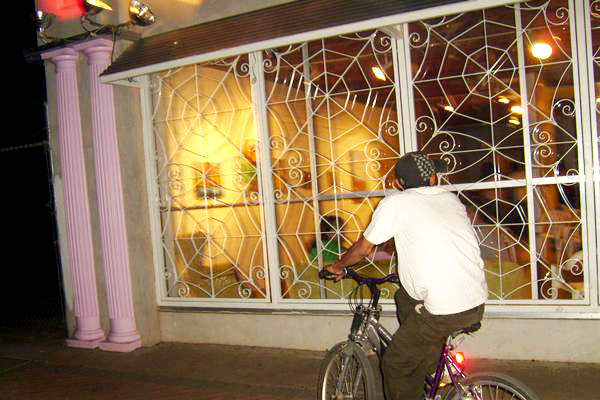
Outside Propaganda on Grand Ave. Photo: Nico Paredes.
Nico is a “sinaloita”, from Mazatlán to be precise. Growing up in La Perla del Pacífico he would listen all kinds of music but his thing was rock & roll, party like an animal, play sports, and kick it with his homies.
“I didn’t listen to banda or música regional or Cumbia, none of that. I was a grunge kid; grew up with Nirvana, Soundgarden, Silverchair, Perl Jam and those Seattle bands.”
Surrounded by so much music, one would think he was into playing instruments, but after a few brewsters at The Lost Leaf, he confessed that he was not good at it. “I took some guitar lessons, but it was pointless,” he says after taking a big gulp of his Sesión Mexican Style Lager. “My homies were musicians, I wasn’t, they were the ones playing in bands and shit.”
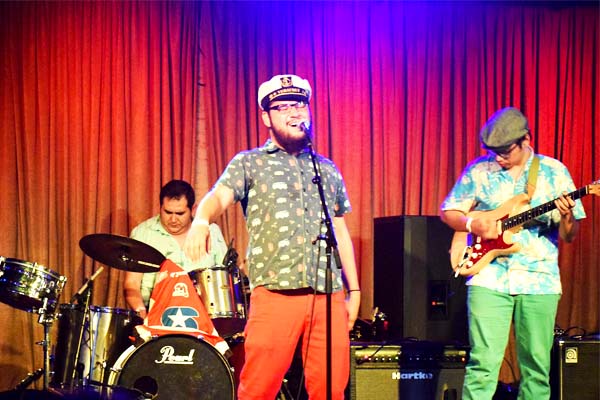
Sonido Cachimbo de Ciudad Juárez, Chihuahua. Photo: Miguel Valenzuela Crescent Moon Photography.
Like many of our generation, Nico grew up watching MTV shows like 120 Minutes, Headbangers Ball or VH1’s Insomniac Music Theater, but is wasn’t like he hated Mexican music or Cumbia like his metalhead friends who said it was crap. “I’ve always liked all kinds of stuff, but it wasn’t like I was buying Banda El Recodo CDs. I would dance to it at parties, but I wasn’t a fan.”
When he was kicking it with friends, they would listen to all kinds of bands like Morrissey, Los Fabulosos Cadillacs, The Pixies, The Smiths or some bands from the British New Wave. It really wasn’t until he got to Texas (he lived there for about 4 years), that he started listening to Afro-Latin rhythms.
He remembers that in Propaganda he would play a lot of electropop like María Daniela y su Sonido Lasser, Silverio, Astro, Milkmoon or Quiero Club. One night, by divine providence he decided to play ¿Qué le pasa a Lupita? by Mi Banda El Mexicano, and everyone lost their shit.
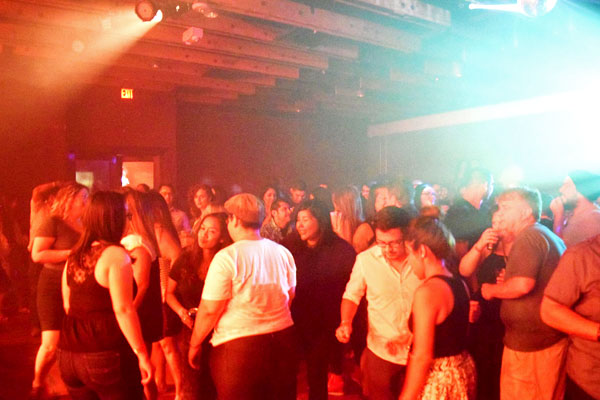
Clandestino @ Crescent. Photo: Miguel Valenzuela Crescent Moon Photography.
“When I saw how la raza got lit, I thought to myself damn, there’s something here, and then I started to find out about bands like Cumbia Mela, Frente Cumbiero, Peligroso, DJs Oro11 or Toy Selectah and the ZZK Records movement.”
Nico realized that people wanted more Cumbia and Afro-Caribbean rhythms and something more danceable than the electropop he played before. That’s when he and Jorge Ignacio decided to create Mexikatek Promotions and bring cool acts to La Phoenikera to places like Casablanca on Van Buren and other small venues.
Propaganda at the time was lit every weekend but according to Nico, the gallery became unsustainable. Plus, they threw way too many parties and the owner of the building told them to stop. A short time after Propaganda closed its doors leaving a void in alternative music shows. Everyone involved went on to do their own thing.
Nico saw the potential and followed the lead of cities that already had an established Latinx music scene. “The idea came about because of a blog post in The Global Experience created by El Güero Único (John Ghost). At a larger scale people were not completely sold on this type of music because some perceived it as tacky, but little by little it started to become cool and people just followed the trend.”
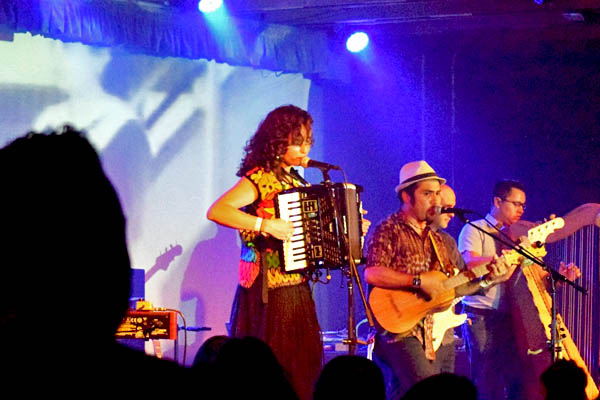
Son Monarcas @ Crescent Ballroom. Photo: Courtesy Clandestino.
Because Cumbia and other Afro-Latinx rhythms are in, Nico says that mainstream artists now collaborate with legendary bands like Los Ángeles Azules in albums such as De Plaza en Plaza (released earlier this year), and the critically acclaimed Cómo Te Voy a Olvidar produced by Toy Selectah and Camilo Lara in 2013. It is also the case with Silverio and his track Perro or his collaboration with La Tesorito (Laura León).
To say that there’s a clear hipsterization of Cumbia is an understatement and generally speaking, it is not a bad thing. It only means that for one reason or another there is a pride in being Latinx and embracing everything that comes with it… Cumbia all of a sudden became cool.
“I don’t know, maybe I’ll get crucified for saying this but I think Latinxs adopt other cultures pretty quickly and when the indie movement reached Mexico and South America, people indulged in it. Now the same bands that trailblazed that movement, are exploring more Afro-Latinx sounds, people are going back to their roots and embracing them,” says Nico.
According to Nico –and really anyone who has danced to Cumbia–, this music is to chillax, be joyous, dance tightly with someone or to have good ol’ fun with your peeps.
“A clear example of how tropical rhythms are just for fun are Los Master Plus or Conjunto La Nueva Ola, which are kind of spoofs, their music is legit but there’s nothing mental about it.”
What Nico loves about Cumbia is that it is very versatile and no matter what your nationality is, you’ll surely dance ’till yo pink panties drop.
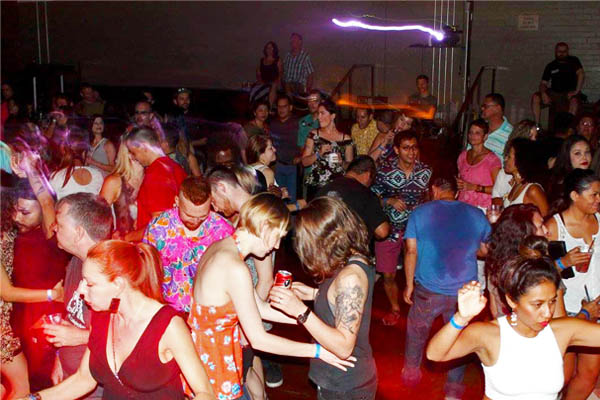
Peeps dancing their chones away at clandestino. Photo: Courtesy Clandestino.
“Cumbia is all about feeling, not thinking, it is easy to enjoy, especially if you grew up with it because it reminds you of family parties or maybe your dad/mom singing to it while taking a shower.”
Cumbia is proliferating like mono in high school and there are people playing it all over. There’s Cumbia being produced in Australia, Japan, Thailand…and there’s El Mayonesa (The Mayonnaise), a dude from Estonia who is dropping jams so cool, Baltic güeros are going gaga for it.
Nico doesn’t think this is cultural appropriation. For him if people are genuine not just takers and they elevate the culture they’re borrowing from –like locals DJentrification and Sir Smeezy–, then it’s not.
He considers appropriation is what some gringo promoters do in La Phoenikera. You know, those who haven’t produced a Cumbia show in their fucking existence, those who don’t give two shits about the cultural value and only care about the dolla signs coming out our pockets.
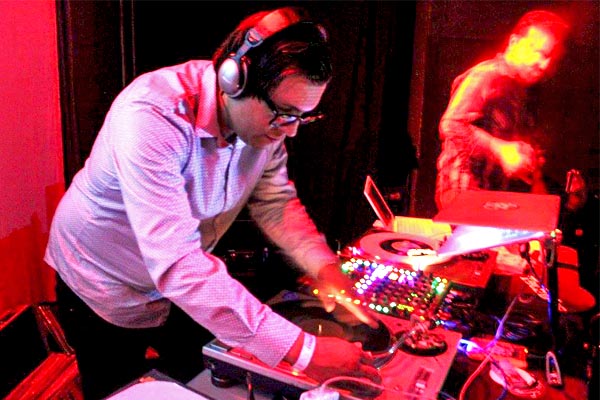
DJ Quitapenas at Valley Bar. Photo: Courtesy Clandestino.
Throughout the years, many ideas that Nico has shared have been stolen and materialized without him, bar concepts, events, etc. But as Nico says, you live and you learn, you find out who is around you and what are their intentions.
That’s why in 2014 he and other local DJs decided to create the Clandestino collective (DJ Tranzo, DJ Musa Mind, DJ Melo y DirtyVerbs from Tucson).
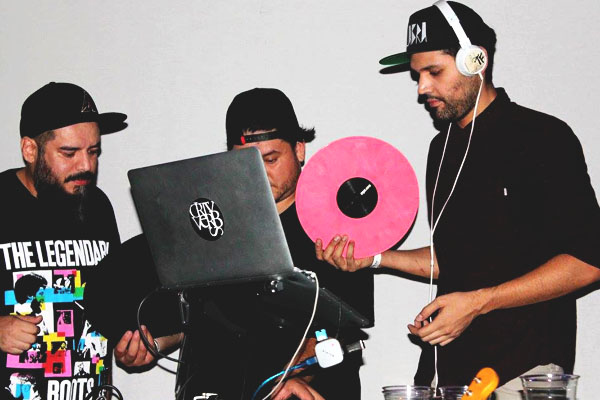
DJ Melo, M.Rocka and DJ Nico. Photo: Courtesy Clandestino.
“One day we were just talking about the project and I was suggesting funny names for it that everyone hated. We were listening to music and then, a Manu Chao song came up –it wasn’t Clandestino–, and I said what if we name it that?” We agreed, one because it sounded cool and underground, but also because originally the event would take place at Valley Bar which is basically a huge basement.”
Initially, Nico just wanted to have fun, throw awesome parties with people that liked the same music and make enough money to be sustainable. But now he has learned his lesson and Clandestino is a legitimate business that several organizations want to partner with to produce larger scale shows, festivals, and conferences.
“Now I want to do the hiring of bands and have higher profile events, partner up with other local promoters to make Clandestino more visible and be more closely involved with the production of culture in La Phoenikera.”
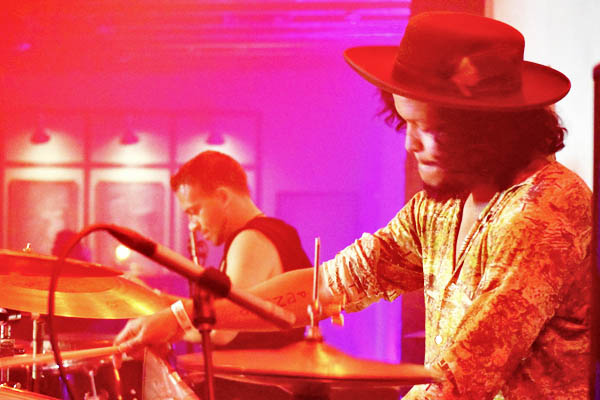
Dos Santos Anti-Beat Orquesta. Photo: Courtesy Clandestino.
La Phoenikera’s Afro-Latinx music scene
Nico believes that because of La Phoenikera’s population growth, the demand for events that represent the 40 percent Latinxs living in the city is also growing.
“Now it’s hip to live in downtown and do things here, I think this is the time to generate culture and have a vibrant scene like L.A., Chi-Town, El Chuco or other cities with large Latinx population,” says Nico.
“It is our job as promoters of culture in La Phoenikera, to produce events that make us proud of our cultural legacy.”
He considers that promoters haven’t partnered up because sometimes Latinx promoters and club owners are close minded when it comes to the events they produce. They’re afraid to try new things, explore new ideas, play alternative music in their venues. They’re scared that their base customers won’t like it. “That’s why there are places that only play banda, salsa, top 40 or rock en español that doesn’t veer from Maná, Caifanes, Panteón Rococó or any other nostalgic rock band.”
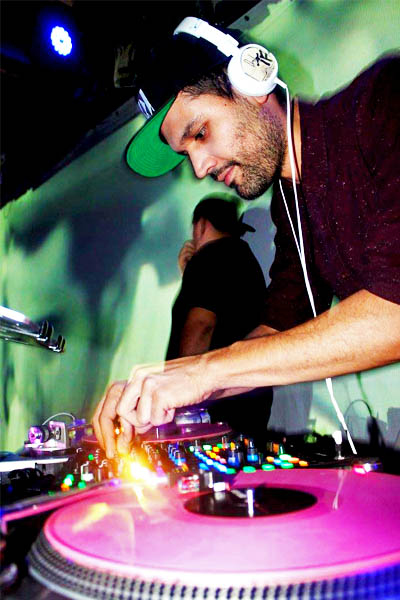
DJ Nico doing his thang. Photo: Courtesy Clandestino.
Clandestino’s masterplan
The idea is to continuously evolve, create partnerships with people that have venues and want to try out something different, maybe even buy a building of its own and have something like La Cita in L.A.
Without hesitation, Nico thinks that downtown La Phoenikera should have its own music venue dedicated to Latinx music.
“If I had a wishlist for a place, it would be something like The Pressroom where you can easily fit 1,000-1,500 people, but that can also be modified to fit smaller crowds for less known bands.”
What interests Nico above all is that people can afford the tickets and not pay $50-$70 per show. “I want to charge 20-25 tops, less if possible. The bands I want to bring are much smaller, progressive and they are doing something out of the norm.”
Promoter’s Rant
One of the challenges Nico has faced over the years as a promoter is making Mexican and South American bands understand that we’re not L.A. That these bands aren’t known in La Phoenikera because, people don’t listen to them, they don’t have airplay, and no one is producing local podcasts to give them exposure, except for a blog called Club Fonograma.
“Some bands think that because they have a following in a major U.S. city, it’s going to be the same here and it doesn’t always work that way. I know that if I bring a Selena cover band I’m going to have a sold out show and it will be a good thing for all the parties involved. But if I want to bring a band like Little Jesus, it’s a gamble because I don’t know how many people have heard of them and expectations can be crushed.”
As our interview was coming to an end, after several beers and slurry questions, I asked what he needs to accomplish his vision to establish a vibrant Latinx music scene in La Phoenikera.
He said he needs predisposition from people who want to create partnerships and use their experience in the entertainment business to create culture.
“I need help from people who are ready to establish a scene that elevates our culture and to have a cool place where people can go and relax, listen to music that’s not being played at other venues, a place where people can say: ‘that’s where my people go, that’s where we can listen to our music.’ And of course, a place where people can dance their ass off.”

